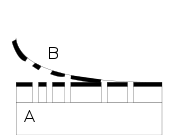
Relief print
Encyclopedia

Printmaking
Printmaking is the process of making artworks by printing, normally on paper. Printmaking normally covers only the process of creating prints with an element of originality, rather than just being a photographic reproduction of a painting. Except in the case of monotyping, the process is capable...
process where protruding surface faces of the matrix (printing plate or block) are inked; recessed areas are ink free. Printing the image is therefore a relatively simple matter of inking the face of the matrix and bringing it in firm contact with the paper. A printing-press may not be needed as the back of the paper can be rubbed or pressed by hand with a simple tool such as a brayer
Brayer
A brayer is a hand roller used in printmaking techniques to spread ink in the process of offsetting an image from a plate to paper.-Materials:...
or roller. Basically the same as Intaglio printing.
The relief family of techniques includes woodcut
Woodcut
Woodcut—occasionally known as xylography—is a relief printing artistic technique in printmaking in which an image is carved into the surface of a block of wood, with the printing parts remaining level with the surface while the non-printing parts are removed, typically with gouges...
, metalcut
Metalcut
Metalcut is a relief printmaking technique, belonging to the category of old master prints. It was almost entirely restricted to the period from about 1450 to 1540, and mostly to the region around the Rhine in Northern Europe, the Low Countries, Germany, France and Switzerland; the technique...
, wood engraving
Wood engraving
Wood engraving is a technique in printmaking where the "matrix" worked by the artist is a block of wood. It is a variety of woodcut and so a relief printing technique, where ink is applied to the face of the block and printed by using relatively low pressure. A normal engraving, like an etching,...
, relief etching, linocut
Linocut
Linocut is a printmaking technique, a variant of woodcut in which a sheet of linoleum is used for the relief surface. A design is cut into the linoleum surface with a sharp knife, V-shaped chisel or gouge, with the raised areas representing a reversal of the parts to show printed...
, and some types of collography
Collography
Collagraphy is a printmaking process in which materials are applied to a rigid substrate . The word is derived from the Greek word koll or kolla, meaning glue and graph, meaning the activity of drawing.The plate can be intaglio-inked, inked with a roller or paintbrush, or some combination thereof...
.
Traditional text printing with movable type
Movable type
Movable type is the system of printing and typography that uses movable components to reproduce the elements of a document ....
is also a relief technique. This meant that woodcuts were much easier to use as book illustrations, as they could be printed together with the text. Intaglio
Intaglio (printmaking)
Intaglio is a family of printmaking techniques in which the image is incised into a surface, known as the matrix or plate, and the incised line or area holds the ink. Normally, copper or zinc plates are used as a surface, and the incisions are created by etching, engraving, drypoint, aquatint or...
illustrations, such as engravings, had to be printed separately.
Relief printing is one of the traditional families of printmaking techniques, along with the intaglio and planographic
Planographic printing
Planographic printing means printing from a flat surface, as opposed to a raised surface or incised surface . Lithography and offset lithography are planographic processes that utilize the property that water will not mix with oil. The image is applying a to a plate or stone...
families. Modern developments have created other types.
In intaglio, the recessed areas are the printed areas. The whole matrix is inked, and the ink then wiped away from the surface, so that it remains only in the recesses. Much greater pressure is then needed to force the paper into the channels containing the ink, and a high-pressure press will normally be required. Intaglio techniques include engraving
Engraving
Engraving is the practice of incising a design on to a hard, usually flat surface, by cutting grooves into it. The result may be a decorated object in itself, as when silver, gold, steel, or glass are engraved, or may provide an intaglio printing plate, of copper or another metal, for printing...
, etching
Etching
Etching is the process of using strong acid or mordant to cut into the unprotected parts of a metal surface to create a design in intaglio in the metal...
, and drypoint
Drypoint
Drypoint is a printmaking technique of the intaglio family, in which an image is incised into a plate with a hard-pointed "needle" of sharp metal or diamond point. Traditionally the plate was copper, but now acetate, zinc, or plexiglas are also commonly used...
.
With planographic techniques, such as lithography
Lithography
Lithography is a method for printing using a stone or a metal plate with a completely smooth surface...
, the entire surface of the matrix is flat, and some areas are treated to create the print image.
Normally relief and intaglio techniques can only be mixed with others of the same family in the same work.
External links
- Types of Relief Printing Descriptions of woodcuts, engravings, linoleum cuts, and monotype relief printing.

